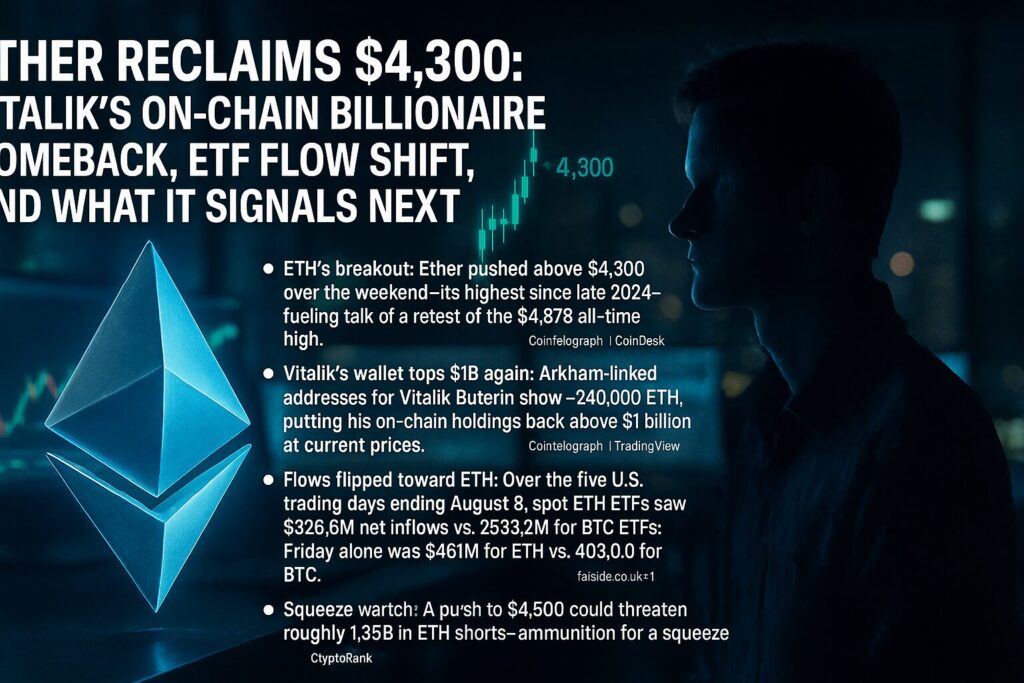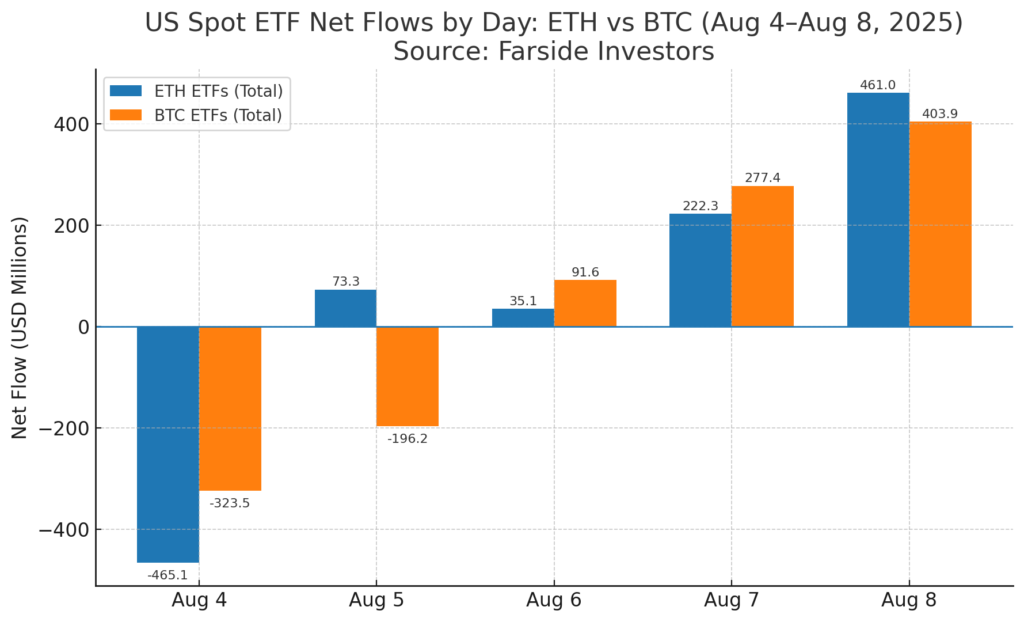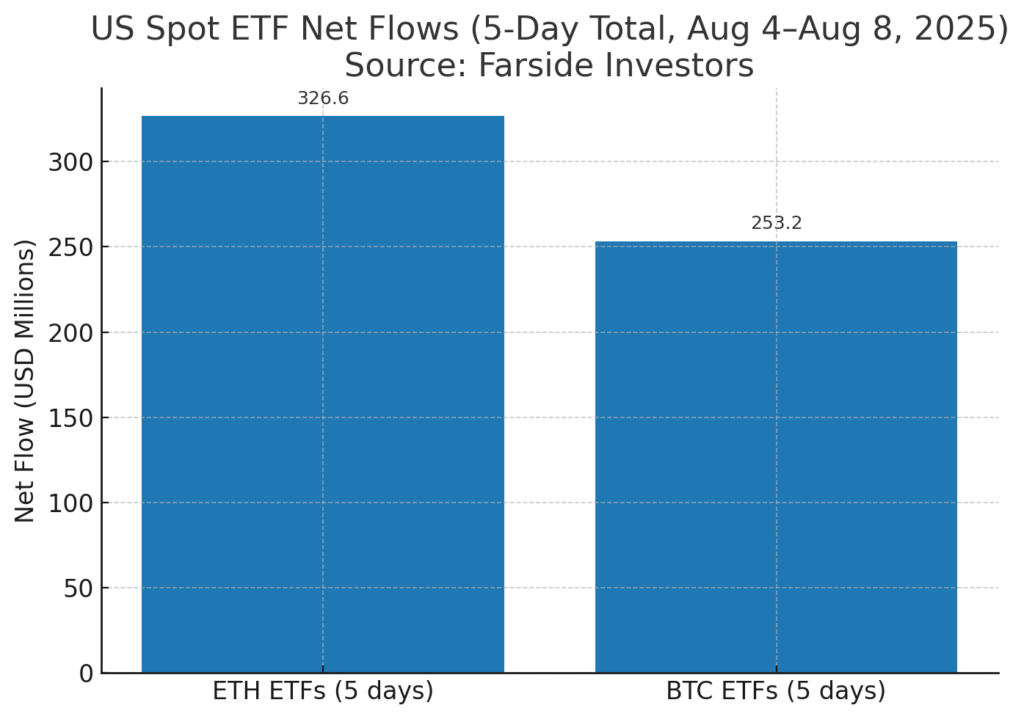
Main points:
- ETH’s breakout: Ether pushed above $4,300 over the weekend—its highest since late 2024—fueling talk of a retest of the $4,878 all-time high.
- Vitalik’s wallet tops $1B again: Arkham-linked addresses for Vitalik Buterin show ~240,000 ETH, putting his on-chain holdings back above $1 billion at current prices.
- Flows flipped toward ETH: Over the five U.S. trading days ending August 8, spot ETH ETFs saw $326.6M net inflows vs. $253.2M for BTC ETFs; Friday alone was $461M for ETH vs. $403.9M for BTC.
- Squeeze watch: A push to $4,500 could threaten roughly $1.35B in ETH shorts—ammunition for a squeeze.
- Corporate ETH treasuries are rising—carefully: Public companies accumulating ETH are now a visible tailwind, yet Buterin warns an “over-leveraged game” could turn a 30% drawdown into cascading liquidations.
1) What just happened?
Ether rallied through key resistance—first reclaiming $4,000, then tagging $4,332—a level not seen since December 2024. The move came with expanding volumes and a marked shift in sentiment, as traders again started to frame the conversation around whether ETH can revisit the $4,878 peak set in November 2021. At publication time over the weekend, Nansen’s feed still showed ETH orbiting about $4,244–$4,300, consolidating the breakout.
This time, the headline wasn’t only price: Vitalik Buterin’s on-chain portfolio climbed back above $1B. Arkham’s wallet cluster places his ETH holdings around 240,000–240,042 ETH, with smaller long-tail positions (AETHWETH, WHITE, MOODENG, WETH). The billionaire label is purely on-chain math—holdings visible on public ledgers multiplied by spot price.
2) The flow story: ETH ETFs steal a march on BTC
Spot ETF flows offered the cleanest quant signal this week. Using Farside Investors data for the U.S. spot products:
- Friday, Aug 8: ETH ETF total net inflow $461.0M; BTC ETF total net inflow $403.9M.
- Five trading days (Aug 4–Aug 8): ETH +$326.6M vs. BTC +$253.2M (summing the daily totals).
These numbers matter for two reasons. First, they confirm fresh demand for ETH exposure through traditional rails after a rough Monday for both complexes. Second, ETH’s relative strength in flows coincided with ETH/BTC outperformance—often a pre-condition for broader altcoin participation later in cycles.
Figure 1 (place after this paragraph): US Spot ETF Net Flows by Day: ETH vs BTC (Aug 4–Aug 8, 2025).

Figure 2 (place immediately after Figure 1): US Spot ETF Net Flows (5-Day Total, Aug 4–Aug 8, 2025).

Those Friday prints weren’t a one-off. They followed a stretch in which Ether ETFs had tallied a record 20-day inflow streak, were jarred by a $465M net outflow day on Aug 4, then quickly snapped back with four consecutive inflow days into Aug 8. The reacceleration is the story.
3) Positioning & the squeeze setup
Derivatives positioning has been a second leg of the bull case. Several desks flagged that a clean break of $4,500 could place ~$1.35B of ETH shorts at risk, per CoinGlass estimates—a setup that can force buy-ins and add momentum at exactly the moment spot ETF flows are favoring ETH. Even before that trigger, breakout days above $4,000 saw $100M+ in ETH short liquidations.
Figure 3 (place after this paragraph): Estimated ETH Short Liquidations at $4,500 Trigger.

4) Vitalik’s billionaire status—then and now
Vitalik first crossed the on-chain billionaire threshold in May 2021, when ETH initially broke $3,000 and his then-333,500 ETH was worth about $1.029B by Etherscan-based calculations. The present rebound differs in composition: fewer coins than in 2021, a larger spot ETF complex, and a market increasingly shaped by traditional capital channels.
5) Corporate ETH treasuries: tailwind with teeth
A new(ish) actor in 2025 is the corporate ETH treasury—publicly listed firms that explicitly hold ETH on balance sheet. One striking example: BitMine Immersion Technologies disclosed 833,000+ ETH (>$2.9B), rapidly becoming the largest publicly traded holder of ETH. This cohort is additive for liquidity, narrative, and visibility—but it also concentrates macro sensitivity if balance-sheet ETH gets levered.
Buterin himself has welcomed the accessibility benefits of such treasuries while warning about a dangerous path:
“If you woke me up three years from now and told me that treasuries led to the downfall of ETH, then… my guess for why would basically be that somehow they turned it into an over-leveraged game.”
His caution is timely: the very flows and narratives that boost ETH today could amplify volatility if margin and structured exposure proliferate faster than risk controls.
6) What could drive the next leg?
- Continued ETF net inflows: If ETH maintains a consistent flow advantage over BTC, relative strength can persist. Friday’s $461M ETH figure—vs. $403.9M for BTC—captured exactly that tilt.
- Derivatives clean-up: Rallying through $4,300 and probing $4,500 can reduce overhead supply and mechanically squeeze shorts, as highlighted above.
- Corporate adoption: Incremental treasury allocations—even small ones—can keep a bid under spot when aligned with ETF creations, provided leverage doesn’t dominate.
7) What to watch (levels, flows, structure)
- Price levels: $4,300 (recent resistance), $4,500 (squeeze risk), and the $4,878 ATH. A firm daily close above $4,300 adds credence to an ATH retest scenario.
- Flow dashboards: Daily ETF prints at Farside (the most practical public tracker). Rising ETH creations on up-days is constructive; persistent outflows on down-days would be a warning.
- Leverage: Funding and open interest imbalances on derivatives venues. Elevated positive funding into resistance can precede sharp wicks.
8) Where the opportunities (and risks) live for practitioners
For allocators and builders focused on new revenue streams and practical blockchain use, ETH’s flow-led comeback intersects three actionable lanes:
- Core ETH exposure with rules
A simple mandate—accumulate on net-inflow days, trim on outflow streaks—now has cleaner signals thanks to public ETF flow data. It’s not perfect timing, but it systematizes behavioral discipline around objective prints. - Ecosystem spillovers
When ETH outperforms BTC and ETF flows are positive, liquidity tends to radiate to L2s, DeFi base assets, and infra tokens. Historically, this is where usage and fee capture show up first (DEX volumes, restaking yields, stablecoin flows). Pair any forays with strict drawdown controls and an eye on derivatives leverage. (Monitoring CoinGlass funding/oi can help avoid crowded entries.) - Treasury-adjacent plays—carefully
Companies explicitly building ETH reserves, or providing services to that cohort (custody, hedging, disclosure tooling), may benefit from the trend. But heed Vitalik’s warning: over-levered balance-sheet ETH is a feature-to-bug flip in a single volatile week.
9) Risks to the view
- Flow reversal: We just watched ETH ETFs post a record $465M daily outflow on Aug 4 before snapping back. Sustained outflows would likely cap upside.
- Leverage overhang: If the rally stalls below $4,500 while funding remains rich, a sharp intra-day reversal could liquidate longs instead of squeezing shorts.
- Macro/policy shocks: Dollar strength, real-rate spikes, or new policy constraints can drain risk bid quickly, including ETF creations.
10) Bottom line
ETH’s surge above $4,300 is more than a number on a chart; it’s a convergence of spot demand (ETF creations), positioning (squeeze potential), and narrative (Vitalik’s billionaire return and the rise of corporate ETH treasuries). The same drivers that make the upside compelling are the ones to risk-manage: leverage and flows. Watch $4,300 → $4,500 → $4,878, and keep one eye glued to Farside’s daily tables.

